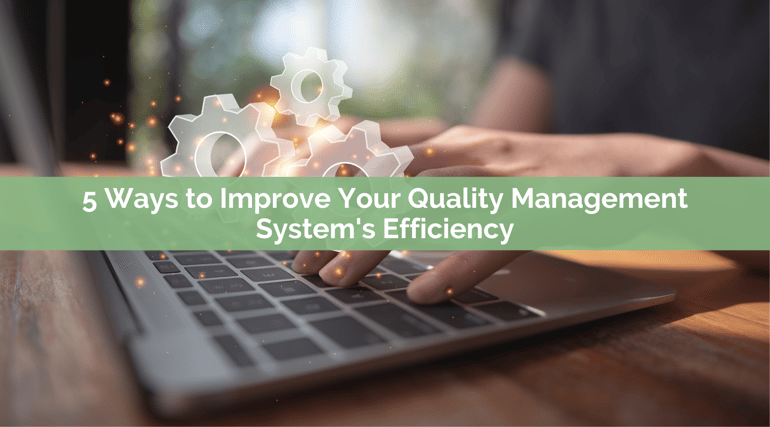
In the landscape of modern business, the quest for excellence is perennial. A cornerstone of achieving and maintaining this excellence lies in the robustness of your Quality Management System (QMS). This blog will delve into five strategies aimed at not just improving but revolutionizing the efficiency of your QMS.
At its core, a Quality Management System is a structured framework that defines an organization's policies, processes, and procedures to ensure product and service quality. It serves as the backbone for maintaining compliance, fostering continuous improvement, and meeting customer expectations. An efficient QMS not only enhances productivity but also contributes to cost reduction, compliance adherence, and, ultimately, customer satisfaction. In an era of constant evolution, an agile and efficient QMS is paramount for sustained success.
1. Streamlining Documentation Processes
Digitalization of Documentation
The transition from manual to digital documentation is akin to upgrading from a typewriter to a computer. The benefits are multifold: reduced risk of errors, improved accessibility, and enhanced collaboration among team members. Digitalization sets the stage for a more agile and responsive QMS.
Implementing a Centralized Document Management System
The chaos resulting from decentralized document management can be mitigated by implementing a centralized DMS system like ENSUR. This ensures that all stakeholders have access to the latest and most accurate information, minimizing confusion, reducing duplication of efforts, and enhancing overall transparency within the organization.
Regular Review and Update of Documents
Documents are not static entities; they evolve with the business environment. Regular reviews ensure that processes are aligned with current industry standards and best practices, preventing the proliferation of outdated or irrelevant information.
2. Employee Training and Engagement
Importance of Well-Trained Staff in QMS
An efficient QMS begins with a well-trained workforce. Effective training management ensures that employees possess the necessary skills to adhere to quality standards, fostering a culture of excellence and commitment to organizational success.
Continuous Training Programs
Learning is a lifelong journey, especially in a rapidly evolving business landscape. Continuous training programs keep employees abreast of the latest industry trends, updates, and technological advancements, ensuring that the workforce remains a dynamic asset to the organization.
Incentives for Employee Engagement in Quality Improvement
Motivated employees are catalysts for positive change. Incentivizing and recognizing employees for their contributions to quality improvement initiatives not only boosts morale but also creates a culture of continuous improvement, where each team member is a stakeholder in the organization's success.
3. Utilizing Technology for Automation
Integration of Automation Tools
The integration of automation tools is not about replacing human efforts; it's about augmenting them. By automating routine and repetitive tasks, organizations can streamline processes, reduce errors, and free up human resources for more strategic and complex activities.
Automated Data Collection and Analysis
In the age of big data, leveraging automated data collection and analysis is a game-changer. Real-time insights into QMS performance empower organizations to make informed decisions, identify areas for improvement, and swiftly implement corrective actions.
Implementation of Software for QMS Processes
Specialized software designed for QMS processes provides a centralized platform for document management, training tracking, and performance monitoring. This not only streamlines workflows but also ensures a more cohesive and integrated approach to quality management.
Continuous Monitoring and Improvement
Regular Audits and Assessments
Routine audits and assessments are not just compliance checkboxes; they are opportunities for improvement. Identifying areas of non-compliance and improvement ensures that the QMS is adaptive to changing conditions and continually aligned with organizational goals.
Utilizing Key Performance Indicators (KPIs)
Key Performance Indicators (KPIs) are the compass guiding the ship. Establishing and monitoring KPIs provide measurable benchmarks for QMS efficiency, enabling organizations to track trends, assess performance, and make data-driven decisions for ongoing improvement.
Feedback Loops for Continuous Improvement
Innovation flourishes in an environment where feedback is not just welcomed but actively sought. Establishing feedback loops within the organization creates a culture of continuous improvement, where insights and suggestions from all levels contribute to the evolution of QMS processes.
Effective Communication and Collaboration
Importance of Communication in QMS
Effective communication is the glue holding the various components of a QMS together. Clear and open communication ensures that all stakeholders understand their roles, responsibilities, and the significance of their contributions to maintaining quality standards.
Collaborative Platforms for Cross-Departmental Cooperation
Breaking down silos is imperative for the seamless functioning of a QMS. Collaborative platforms facilitate communication and cooperation across different departments, fostering a holistic approach to quality management.
Regular Feedback Sessions and Communication Channels
Establishing regular feedback sessions and communication channels is the bedrock of a transparent organizational culture. Open dialogue allows for the identification of challenges and the implementation of timely solutions, further enhancing the efficiency of the QMS.
The journey towards an efficient Quality Management System is not a sprint but a marathon. By implementing the strategies discussed—streamlining documentation processes, investing in employee training and engagement, utilizing technology for automation, continuous monitoring and improvement, and fostering effective communication and collaboration—organizations can embark on a transformative path toward excellence.
To take the first step towards a more efficient QMS, consider reaching out to DocXellent. With their expertise in document management solutions, they can play a pivotal role in tailoring solutions to align with your unique needs and goals.
Contact DocXellent today for personalized guidance on how to propel your organization toward a more efficient and effective Quality Management System. Your journey to unlocking excellence starts here.
-1.png?width=6000&height=900&name=Blog%20Author%20Headers%20(3)-1.png)
Amy Sinyei Rodrigues is DocXellent's Chief Customer Officer. In this role, Amy works with our customers to make sure they are getting the most they can out of our Document Management Software, ENSUR. After graduating with a BS in Industrial Engineering and an MBA in General Management, Amy worked with several enterprise software and solution services providers in the electronic discovery industry before bringing her years of expertise and valuable education to DocXellent 6 years ago. Learn more about Amy and the work she does for DocXellent here.




























